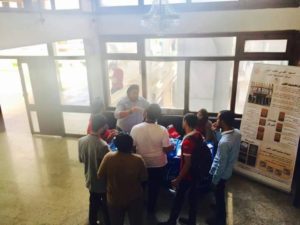 Faculty of Engineering, Cairo University, organizes Annual Job Forum to connect between the faculty student and the Market. EPS CYMS joined the event titled “Biomedical Engineering Careers in the Market” that was held in the conference room of the faculty of Engineering, Cairo University, May 2016 with an attendance of more than 250 students of biomedical engineering from all over Egypt.
Faculty of Engineering, Cairo University, organizes Annual Job Forum to connect between the faculty student and the Market. EPS CYMS joined the event titled “Biomedical Engineering Careers in the Market” that was held in the conference room of the faculty of Engineering, Cairo University, May 2016 with an attendance of more than 250 students of biomedical engineering from all over Egypt.
During the event, CYMS disseminated flyers and talking in person with the attendees introducing EPS and CYMS to define the vision and the mission of the section, as well as the annual plan and the previous and future events that the section and how to join the section. The students did not have any knowledge about the society and its course of contribution. By the end of the day, they were interested in joining the section in its new plan and following us in our different social media accounts and of spreading all over the universities
Scientific day
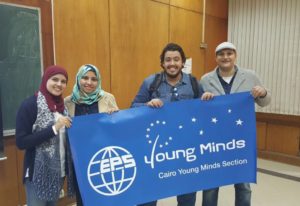 Since it’s an essential knowledge for students who work in one research group, also for us the section members, the day started with a speech about (How to work in a team). The main idea was connecting Science with industries by calling one of related industrial companies in field of optics; Scope Optics Company. Its owner and representative, Dr. M. Abd Elazeem was invited to give a speech and he responded pleasantly. The last seminar was given by Lecturer Yusuf and he is also the section treasurer talking about his work which helps central retinal impairment patients to get the overall visual scene.
Since it’s an essential knowledge for students who work in one research group, also for us the section members, the day started with a speech about (How to work in a team). The main idea was connecting Science with industries by calling one of related industrial companies in field of optics; Scope Optics Company. Its owner and representative, Dr. M. Abd Elazeem was invited to give a speech and he responded pleasantly. The last seminar was given by Lecturer Yusuf and he is also the section treasurer talking about his work which helps central retinal impairment patients to get the overall visual scene.
The event took place in The National Institute of Laser Enhanced Sciences (NILES) supported by Laser Technology Center (LTC). It helps NILES’s staff members and LTC’s members to relate about optical industrial technologies, and optical fabrication stages. Moreover the invented ophthalmic co-axial bi-cone lens Presented by Yusuf. All the section members where involved in the event arrangements. Professors, researchers and students had been invited to this event, and more than 15 attended. a visit to the production place was suggested to extend the knowledge for the upcoming events through the team of EPS Cairo Young Minds section.
Pizza Event!!!
With this title we started an event called “Welcome Young Minds” through which we invited undergraduate students from Faculty of Engineering, Cairo University after finishing their training at National Institute of Laser Enhanced Sciences (NILES) – Cairo University.
They didn’t hear about society and Cairo Young Minds Section before, so it was a great opportunity to welcome them in a short seminar about the goals of our section, and the activates we attend to do . This all happened during a “PIZZA PARTY” yummy yummy!!!!!
This event started with introduction about each member then presentation which contained our goals, methods to reach these goals, and ended by eating PIZZA during good discussion about what we can collaborate to do with them in the next time.
Optical Workshop & Youth Education
 In order to explain some optical phenomena as the reflexion, the refraction, diffraction, the scattering, the absorption and the emission of the light we made an OPTICAL WORKSHOP. In these workshops, we visited schools of different academic levels and we did easy and fun experiments to prove to children and to young people that the science is closer to them. We tried to show them that the science is important in our daily life and that everybody can study science. We usually participate in workshops organized by the University Jaume I. In this year, we participated in the following University’s workshops: 1) “Practica a l’UJI”, 2) “FIRUJICIENCIA 2017”, 3) “Colònies Cientìfiques a L’UJI 2017” and 4) “Connect amb la Ciència de la Universitat Jaume I”. It should be noted that our activities were successful, considering that were attended more than 500 pupils. On the other hand, we can say that in the most cases, the optical workshops have become the first contact of society with the science and with our university. Finally, we believe that these workshops help us to promote our outreach activities and the University Jaume I. Moreover, we have shown to the children and teenagers that to study science can be a good option.
In order to explain some optical phenomena as the reflexion, the refraction, diffraction, the scattering, the absorption and the emission of the light we made an OPTICAL WORKSHOP. In these workshops, we visited schools of different academic levels and we did easy and fun experiments to prove to children and to young people that the science is closer to them. We tried to show them that the science is important in our daily life and that everybody can study science. We usually participate in workshops organized by the University Jaume I. In this year, we participated in the following University’s workshops: 1) “Practica a l’UJI”, 2) “FIRUJICIENCIA 2017”, 3) “Colònies Cientìfiques a L’UJI 2017” and 4) “Connect amb la Ciència de la Universitat Jaume I”. It should be noted that our activities were successful, considering that were attended more than 500 pupils. On the other hand, we can say that in the most cases, the optical workshops have become the first contact of society with the science and with our university. Finally, we believe that these workshops help us to promote our outreach activities and the University Jaume I. Moreover, we have shown to the children and teenagers that to study science can be a good option.
Students Meeting at the Start of the Semester
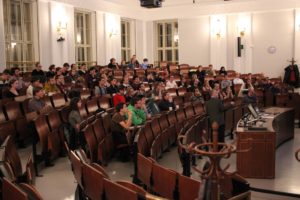 The Students Meeting at the Start of the Semester took place for the fourth time and is beginning to have the status of an established event at the Faculty of Nuclear Sciences and Physical Engineering (FNSPE). This was mirrored by the high attendance of almost 70 people which increased again, compared to the previous semester. As usual, we invited a high-profile speaker in the Czech Republic to give a talk at our university. This time, because of the recent Nobel Prize in the field, we invited Prof. Jiri Podolsky from Charles University to speak about gravitational waves which is the main topic of his research.
The Students Meeting at the Start of the Semester took place for the fourth time and is beginning to have the status of an established event at the Faculty of Nuclear Sciences and Physical Engineering (FNSPE). This was mirrored by the high attendance of almost 70 people which increased again, compared to the previous semester. As usual, we invited a high-profile speaker in the Czech Republic to give a talk at our university. This time, because of the recent Nobel Prize in the field, we invited Prof. Jiri Podolsky from Charles University to speak about gravitational waves which is the main topic of his research.
The event was advertised in a timely manner on our increasingly popular Facebook profile, on our web pages, and in the form of posters in several buildings of Czech Technical University and Charles University. Students and faculty from several universities came and enjoyed coffee and tea before the lecture and then attended the presentation. During the subsequent discussion, which is in our opinion the most important part of the event, they enjoyed refreshments organized by us. During the event, we also advertised other activities organized by the Prague EPS YM section.
This event was generally rated as a good idea. The large attendance makes this the most popular single event organized by our EPS YM section and was achieved mainly thanks to the large number of posters that were distributed at the university campuses in Prague. The meeting presents a unique networking opportunity that can connect faculty and students of different ages and from different universities. In addition, such an event can be interesting for the public as well. All these reasons accentuate the need of such high-profile talks at our university.
NASA Space Apps Challenge 2017
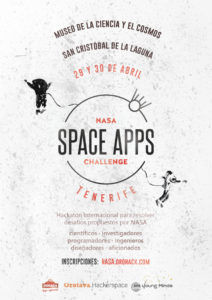 Since its inception in 2012, the International Space Apps Challenge, a part of NASA’s Earth Science Division, has become the world’s largest global hackathon, engaging thousands of citizens each year across the globe to work with NASA in building innovative solutions challenges we face on Earth and in space using open source data. Space Apps inspires local innovation communities in cities across six continents to convene, ideate and build. Diverse and collaborative teams of technologists, scientists, designers, entrepreneurs, and others work together in a 48-hour sprint to develop answers to some of the most pressing challenges facing planet Earth using NASA data. Over 25,000 citizens from 69 countries and in 187 cities around the world participated in the 2017 International Space Apps Challenge.
Since its inception in 2012, the International Space Apps Challenge, a part of NASA’s Earth Science Division, has become the world’s largest global hackathon, engaging thousands of citizens each year across the globe to work with NASA in building innovative solutions challenges we face on Earth and in space using open source data. Space Apps inspires local innovation communities in cities across six continents to convene, ideate and build. Diverse and collaborative teams of technologists, scientists, designers, entrepreneurs, and others work together in a 48-hour sprint to develop answers to some of the most pressing challenges facing planet Earth using NASA data. Over 25,000 citizens from 69 countries and in 187 cities around the world participated in the 2017 International Space Apps Challenge.
With this, we decided to host the very first NASA Space Apps Challenge in Canary Islands, with 30 participants over the course of two days of work and fun with science and data from NASA and other open repositorires.
This year, the challenge focused on a certain topic, Earth, divided in five different categories:
– The Earth and Us, which mainly consisted in combining NASA Earth Science data with other sources to obtain some short of human-environment interactions.
– Planetary Blues looked for visualizations and analysis of the hydrosphere and cryosphere in novel ways.
– Warning! Danger Ahead! was all about natural disasters through data.
– Our Ecological Neighborhood focused on studies about ecological systems.
– Ideate and Create! asked participants to use data in new creative ways as a more open challenge.
The participant where divided in three teams where each focused on one category, creating a wide variety of results. Yugarta Project focused on the display of whales migration routes and created an app to explain their journey and raise awareness. Rambo is on Fire designed a monitoring system for forest fire which mixed satellite data with drone monitoring on the field, creating a more efficient and effective system. Finally, Guardians of the Earth decided to take their own lead and develop different formulas to reduce pollution with two active systems for the reuse of combustion byproducts, mainly CO2.
Sadly, none of the projects done in this venue was able to reach the global finals. However, the participants were really pleased at the end of the event and asked for more editions in the future.
Thanks to the support of the EPS we were able to pay for food, beverage, office supplies and promotional materials. The local Science Museum of Tenerife hosted the event and Dorada donated some extra beverages.
A report and a explanatory video of each team can be found on the website of the event:
https://2017.spaceappschallenge.org/locations/tenerife/
You can find the full album of the event on Facebook:
https://www.facebook.com/Space-Apps-Tenerife-1272997179416727/
Let’s make fun with science: Sun, light and colored shadows
According to the spirit of the “Let’s mak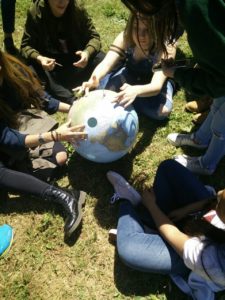 e room for science!” project, aimed at discovering the concepts of gravity, energy and light, the EPS Young Mind Section of Rome developed new activities concerning the same topics also in the last months of 2017. These activities were partially founded by the 2017 Activity Grant.
e room for science!” project, aimed at discovering the concepts of gravity, energy and light, the EPS Young Mind Section of Rome developed new activities concerning the same topics also in the last months of 2017. These activities were partially founded by the 2017 Activity Grant.
Thanks to the collaboration with the Physics Department of the University of Roma Tre, we started organizing guided observations of the Sun using the solar telescope of the Department. The observations were dedicated to children and young kids from local schools, but they also gave us the opportunity to involve undergraduate students of the Department, who immediately proved not only to be curious about the telescope, but also to be ready to tell themselves what they knew about the Sun to the younger children. During these observations, we also used little globes that could be oriented in order to simulate the illumination state of our Earth, so that participants could learn about the apparent motion of the Sun in the sky during the day, the seasons, equinoxes and time zones.
The concept of light was investigated also with a new exhibit: the “Colored shadows”. We started with three lightbulbs of red, green and blue light, aiming them all at a white screen. A pencil placed in front of the lights would then have not just one, grey shadow, but three and more colored shadows! Turning off one of the colored lights, it was then possible to notice how the color on the screen changed. This simple exhibit allows to deal with different concepts. First of all: the way in which our eyes are able to perceive colors (we have only three types of receptor called cones, that can see the red, green and blue light – from their combination, we are able to perceive millions of different colors). But then it is possible to talk about how the light travels in a straight line. And obviously, how the colors mix to form new shades.
The “Colored shadows” exhibit was used during the European Researcher’s Night 2017 at Roma Tre University. It drew the attention of lots of children who enjoyed watching their ever-changing shadows, but also the young students who were curious to discover the reasons why they were seeing those particular colors.
At the end, the “Let’s make fun with science: Sun, light and colored shadows” project had more than 300 participants between primary, secondary schools students and general public.
School for Young Physicists
 This semester, SYP (School for Young Physicists) kicked off its 8th season in style. In September, the main topic was military physics, and the session was very special. For starters, the topic garnered great interest from students, and a capacity number of 320 (!) students attended, which was a monumental increase over the previous record of 250 people. Managing such a large crowd is a great challenge, but our organizing team did a splendid job in making sure everyone was attended to.
This semester, SYP (School for Young Physicists) kicked off its 8th season in style. In September, the main topic was military physics, and the session was very special. For starters, the topic garnered great interest from students, and a capacity number of 320 (!) students attended, which was a monumental increase over the previous record of 250 people. Managing such a large crowd is a great challenge, but our organizing team did a splendid job in making sure everyone was attended to.
However, this was not the only extraordinary thing to happen – after the popular lectures, the experimental part had students doing all kinds of military related things, for example – decoding messages and working with electronic sonar detectors, but the main attraction was shooting with paintball guns and analyzing the trajectory of the paintballs experimentally and theoretically.
For the last in-depth lecture we had a representative from the Latvian Army and two Canadian army officers – one a PhD in physics – who gave lectures about their everyday work and the role of physics in it. This event caught enough attention that the Army sent over a reporter crew to film the entire process, which was a first for SYP.
After the first session, attendance rates remained very high, stabilizing at 250 attendees for every session until December. In later sessions, we looked at radioactivity and nuclear physics, at chemical physics and at thermal physics. In all cases, students learned something outside of the school curriculum. Highlights include a popular lecture introducing students to the topic of quantum physics in chemistry and an experiment with colored ice cubes visually demonstrating the effects of convection in a glass of water.
This semester, our team has not only facilitated the ever-growing sessions in Latvia’s capital, Riga, but also slightly expanded our reach across the country. Previously, we only held sessions in Valmiera, Kuldiga and Ventspils, but now a new city has joined the fold – we will also hold sessions in the regional center Rezekne.
The schools that we’ve visited thus far have all shown willingness to continue to work together, and have asked if classes for younger students than Grade 10 are available. As a consequence, our team also occasionally hosts tailor-made sessions for the younger students, involving them as well.
We’ve also done numerous projects that are directly not connected with our sessions – our team has constructed a physics prop (a large scale wave pendulum) for a TV show and taken part in creating exhibitions for museums (specifically, an interactive stand about the working principles of a light bulb, a phone and communications systems). Slowly but surely, SYP is garnering a reputation for being able to present physics in an interesting, educational and simple manner not only to high school students, but to people of all ages and walks of life.
Altogether, the first semester of SYP’s 8th season has been a record-setting one, and we look forward to keeping the upward trend going in 2018.
Researcher’s night
In 2017, as a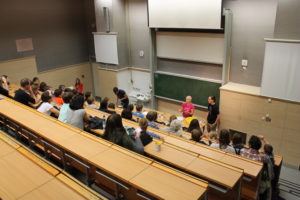 lways we organised Researcher’s Night for the physics institution of Eötvös Loránd University. This event is held nation-wide and takes place in several universities, museums and research institutes. It’s main goal is to educate mostly children, or anybody visiting in a fun, yet informative way to show them interesting aspects of science that they most likely won’t see in school.
lways we organised Researcher’s Night for the physics institution of Eötvös Loránd University. This event is held nation-wide and takes place in several universities, museums and research institutes. It’s main goal is to educate mostly children, or anybody visiting in a fun, yet informative way to show them interesting aspects of science that they most likely won’t see in school.
The event started mid-afternoon. Visitors could choose from numerous different themes of physics, we had five desks full of various experiments. The themes of these were mechanics, hydrodinamics, electricity, optics and thermodinamics. Parts of the experiments were especially interesting for the younger audience, since they could touch new materials or hold unfamiliar tools and also for teenagers and adults. We purchased varied tools from the grant, such as prisms and lasers, which all were highly popular among the guests. The more dangerous things were handled by demonstrators, who were students at the university.
The other major section of the night were the lectures. These were designed to be clear and interesting, suitable both for young children and their parents. One was held by a university student, the vice president of BYMS. He talked about the structure of the universe. Our other lecturer was an associate professor at our physics institution. He presented the Big Bang Theory, the quark-gluon plasma and the experiments currently going on in CERN.
A few people from different research institutes were visiting us to see the event. Since they all liked our program, it is very likely we will be able to work together with them in the following years to make the event bigger.
You can find more pictures in:
https://1drv.ms/f/s!AnNl0GK68LZFkU9sL54mtxNCyTac
European Researchers’ Night 2017 in Naples
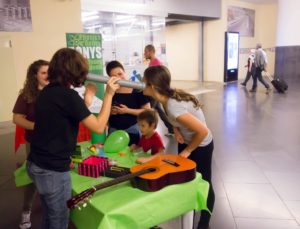 On September 29th, for the second time PONYS joined the European Researchers’ Night (ERN) 2017 by participating to an outreach event in Naples. The main organizer was Frascati Scienza, who managed the events in more than 10 cities of Italy.
On September 29th, for the second time PONYS joined the European Researchers’ Night (ERN) 2017 by participating to an outreach event in Naples. The main organizer was Frascati Scienza, who managed the events in more than 10 cities of Italy.
The event we joined has been organized in the Municipio Metro Station thanks to the network with the Section of Naples of the Istituto Nazionale di Fisica Nucleare (INFN) and the Azienda Napoletana Mobilità (ANM), the local public transport company.
For the second time, we chose a daily life place, in order to reach a higher number of people and talk with them about science. Everyone who had to take or took the metro, made a stop to the PONYS exhibit, where they have been involved in easy scientific demonstration. In each exhibit, PONYS volunteers showed scientific experiments with everyday material: a lamp, a guitar and microwave oven turned out to be useful in explaining the fundamentals laws of optics and acoustics, with common examples.
Ponys’ exhibits weren’t the only attraction of the ERN in Naples. Actually, the Metro station itself is a touristic place, since the building is very ancient and it is well integrated with the archeological ruins found during the construction of the metro and also with the walls of one of the most ancient castle, called Maschio Angioino which stands out against the square. Thanks to the INFN-Section of Naples, one of the lateral facade of the Castel, was animated with a projection of short science video. In order to facilitate the communication with people, the short videotape was composed by cartoon bubbles, which describe many physics and optics applications. It has been a fundamental experience of professional growth for PONYS. We had the chance to join one of the most important scientific event in Europe. But the most enthusiastic experience has been our relation with our people and city: it was great being in one of the most ancient and famous place of Naples, sharing physics!
Thanks to all our partners.
